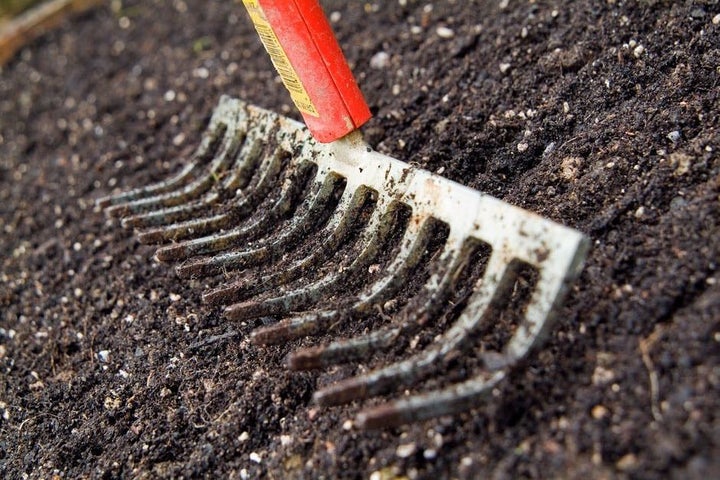
Quick facts
Timing - Autumn (Sept-Nov) or mid-spring (March-April)
Difficulty - Easy
Why and when to sow
Growing a lawn from seed has several advantages over turf:
- it’s less expensive
- there’s a wider choice of seed mixes to suit different conditions
- seeds are easier to transport
- seeds can be kept until the weather conditions are ideal, whereas turf deteriorates if not laid soon after delivery
However, growing from seed does take a little longer.
Lawn seeds germinate best in early autumn and mid-spring. The soil is warm, there’s plenty of moisture and the weather is neither too cold nor too hot. should take from seven to ten days.
If you have a choice, early autumn is the better option, as the can get established before the first hard frosts, then will root in well through the winter. When sown in spring, the grass may not root in as quickly, as it will instead put its energy into flowering.
Choosing the right seed mix
To get a lawn that suits your needs and your site, take care to choose the right seed blend.
General-purpose lawn – a mix of hard-wearing grasses that can stand up to a lot of wear and tear, from regular foot traffic, children and pets. Usually a blend of ryegrass, tall fescue, red fescues and browntop. The lawn will grow quite fast and require regular mowing.
Luxury or fine lawn – a blend of fine-leaved turf grasses that are less robust, but form dense, soft lawn. Usually a blend of Chewing’s fescue, strong and slender creeping red fescue and browntop. These are slow-growing grasses and can be mown at a low height for a neat finish.
Shady lawn – for light to medium shade, such as under trees and beside a fence or hedge. Most contain hard fescue, strong and slender creeping red fescue and browntop. These are fine-leaved grasses and usually not very hard wearing.
There are many other seed mixes available – such as for drought-tolerant lawns, easy-care lawns, quick lawns and so on – but take a look at the ingredients and you’ll probably find they’re similar to one of the three options above.
TOP TIP: buy good quality seed
You generally get what you pay for – cheap lawn seed may contain weeds or coarse agricultural ryegrass, making a lawn that’s more suitable for grazing sheep than family barbecues. So choose a reputable brand and check the ingredients – any perennial ryegrass must be ‘turf’ or ‘fine’ ryegrass.
Preparing your sowing site
Good preparation will help to ensure you get a top-quality lawn – one that is level, dense, well-rooted and weed-free. Ideally, start getting the area ready several weeks before sowing:
- Take care to remove all weeds, such as couch grass and bindweed, well in advance. Dig out their roots – see our guide to non-chemical control methods
- If the soil is hard and compacted, dig or rotovate to a depth of about 20cm (8in)
- If your soil is light and fast draining, add plenty of well-rotted manure or home-made compost to help hold moisture in the soil
- After digging, leave for several days to settle – the longer the better, ideally five to six weeks
- Weed again if necessary, off or hand-weeding regrowth of perennial weeds
- Firm the soil by treading the area several times in different directions, using small, shuffling steps
- Then rake the surface thoroughly in various directions to create a level surface, remove any large stones and break up any clumps of earth, creating a fine, crumb-textured seedbed
- You can also rake in a general-purpose fertiliser, at a rate of 70g (2oz) per sq m (sq yd)

How to sow a lawn
Sowing a lawn is a simple process, but it’s important to scatter the seeds as evenly as possible to get a good result. Follow our steps below.
- Weigh out the correct quantity of seeds for the size of your new lawn – the weight per square metre will be given on the packet (it can vary depending on the seed mix)
- Then divide the seed into two equal batches
- Sow half the seeds over the whole area by walking up and down in parallel rows, scattering the seed as evenly as you can
- Repeat the process with the second batch of seeds, walking from side to side this time
- Lightly rake over the sown area to cover the majority of the seeds with soil
- If no rain is forecast for a few days, water gently with a light spray, ensuring the seeds aren’t dislodged
- Protect the seeds from birds by covering with horticultural fleece, weighted down at the edges. This should also improve by keeping the soil warm and moist. On a larger scale, try using bird tape, which produces a humming noise as the wind vibrates it. Alternatively, increase the sowing rate by 50 per cent to compensate for losses
- Water every few days, if necessary
Looking after a new lawn
Grass will appear a week to ten days after sowing. To ensure your new lawn establishes well, follow our key tips:
- Water the seedlings regularly if it doesn’t rain, using a watering can with a rose or a hose with a gentle spray
- When the seedlings are 5–7.5cm (2–3in) tall, lightly refirm the soil, ideally with a garden roller or the rear roller of a cylinder mower/rotary mower. Alternatively, gently tread any raised areas
- Two or three days later, cut the grass, reducing it by only about one-third of its height. Ideally use a cylinder-bladed mower, but remove the front roller to prevent it flattening the grass. Ensure the blades are really sharp
- For autumn-sown grass, no further mowing is usually necessary until the following spring
- For spring-sown grass, cut every week or so, as required, progressively lowering the height of the blades until they’re back at the normal level. But in hot weather, keep the blades high or stop mowing for a while
- Weed seedlings are usually killed when mowing begins, but any low-growing weeds are best weeded out by hand. If very coarse grasses appear, remove these too.
- Use the lawn as little as possible for about eight months. If autumn-sown, try to avoid using it earlier than June, if spring-sown, use it as little as possible up to late autumn
- If any dips appear as the ground settles, add a thin layer of sieved potting (top-dress) in September
- You can also apply lawn feed in spring – see our guide to spring lawn care










